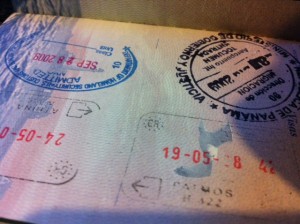Traditionally, some of the most painful experiences in traveling internationally have taken place before the trips even begin.
No, I’m not talking about buying the plane tickets, though that can be painful as well. I’m not even talking about packing your bags to satisfy TSA requirements.
I am talking about obtaining visas, especially for certain countries that seem to do everything they can think of to discourage visitors from actually coming and spending money within their borders — just about as short-sighted a policy as you can get, since tourism is now the world’s number one industry.
And yes, the U.S. is one of those countries. I wrote about Brazil sparring with the U.S. over mutually restrictive visa requirements in an earlier post.
But now, things are loosening up a bit, according to a report by the UNWTO World Tourism Organization.
As chronicled by skift.com, the report shows the trend toward less red tape in issuing visas is moving in a positive direction: of the 5,000 or so changes in visa requirements around the world in 2011 and 2012, some 70 percent involved allowing travelers to get visas on arrival when they reach their destinations, rather than having to obtain the documentation before leaving home.
In other words, there’s no need to make time-consuming and laborious trips to the local consulate or embassy, no need to hire expensive visa services as your trip fast approaches, no need to mail off your passport into the black hole of bureaucracy-land, perhaps never to see it again.
Five years ago, the report continues, more than three-quarters of people around the globe had to apply for traditional visas in advance before departure. That’s now dropped to 63 percent.
It’s no coincidence that 2012 saw a billion international travelers for the first time in history.
Countries such as China, India, Myanmar and, yes, Brazil have been leading the way toward more relaxed requirements, as they shop for tourists and business travelers to boost their economies. Issuing visas on arrival have helped Turkey more than double its number of international visitors in the past decade.
E-visas, delivered digitally, are another convenience looming on the horizon.
But while emerging countries are making it easier to attract visitors, North America is lagging behind. Barely more than 10 percent of the world’s population can enter the U.S. without a visa, compared to about 25 percent for other advanced countries.
Still, the U.S. has recently eased visa restrictions on citizens from Brazil and China, among others. In turn, this makes it more likely that those countries and others will ease restrictions on Americans.
While these developments affect all travelers, not just baby boomers, I see this as a particularly positive development for boomers and our aging knees: standing in line at consulates and embassies — I once waited for four hours at the Russian consulate for a visa application before being told to return the next day and try again — only gets tougher as the years pass.
Not that boomers are old, you understand. But we may not have infinite time left to travel, either — and I for one would rather spend my time waiting in line at a museum or even a hot new restaurant than in obtaining a visa from a surly consular agent. Countries that make it easier to visit will win more boomer business, that I can guarantee.
Be sure to download my free report, “How to Ride the Coming Wave of Boomers,” available here. It’s all about the best ways to market travel to baby boomers — the biggest-spending group of travelers the world has ever seen. It’s also the easiest way to subscribe to my blog, so you won’t miss a posting. Thanks!













One Response to Relaxations on Travel Visa Requirements Are Good News